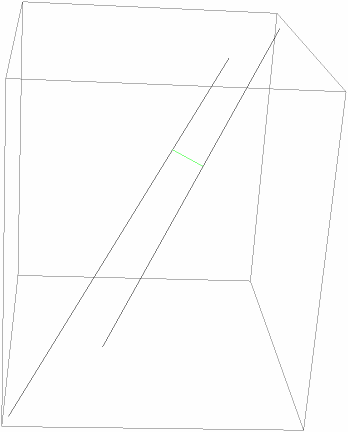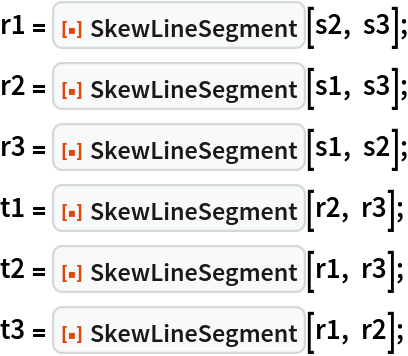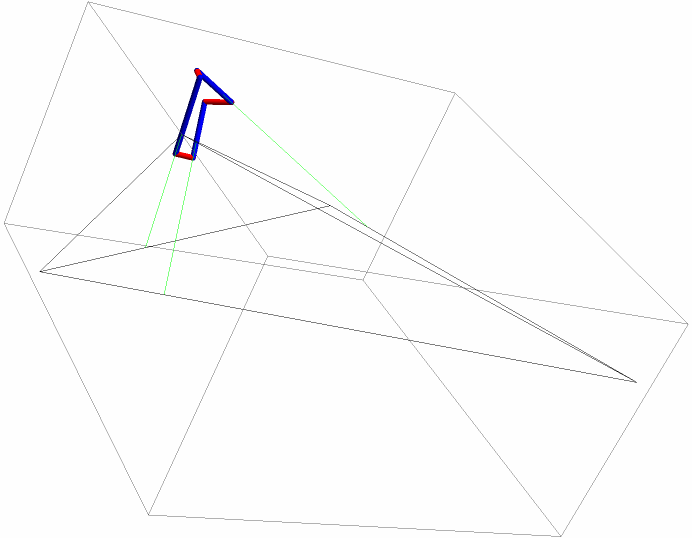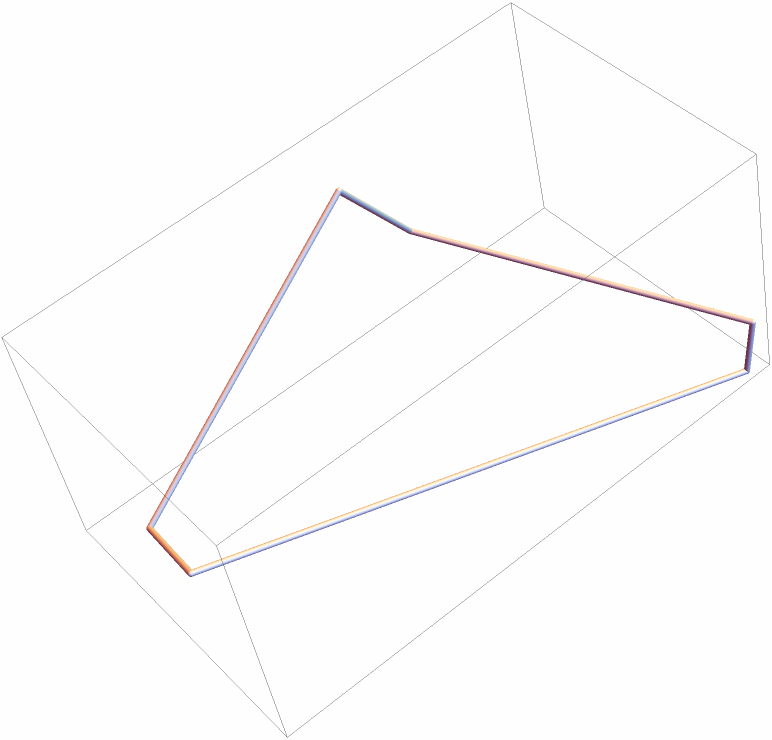Wolfram Function Repository
Instant-use add-on functions for the Wolfram Language
Function Repository Resource:
Get the shortest segment between skew lines
ResourceFunction["SkewLineSegment"][j, k] return the shortest segment between skew lines j and k as a 3D coordinate pair. | |
Find the shortest segment between two skew lines:
| In[1]:= | ![line1 = {{3, 1, 4}, {1, 5, 9}};
line2 = {{2, 6, 5}, {3, 5, 8}};
dat = ResourceFunction["SkewLineSegment"][line1, line2]](https://www.wolframcloud.com/obj/resourcesystem/images/2ec/2ec109f0-32a9-4668-9ed9-33c6c90c384b/34848151d1d4bf7f.png) |
| Out[3]= |
A list of lines may also be used:
| In[4]:= |
| Out[4]= |
Show the lines and segment:
| In[5]:= | ![Graphics3D[{InfiniteLine[line1], InfiniteLine[line2],
Green, Line[dat]}, ImageSize -> Small]](https://www.wolframcloud.com/obj/resourcesystem/images/2ec/2ec109f0-32a9-4668-9ed9-33c6c90c384b/66db528c8f22f821.png) |
| Out[5]= |  |
When two skew lines are Line objects, the returned segment is a Line:
| In[6]:= | ![line1 = Line[{{2, 7, 1}, {8, 2, 8}}];
line2 = Line[{{1, 8, 2}, {8, 4, 5}}];
dat = ResourceFunction["SkewLineSegment"][line1, line2]](https://www.wolframcloud.com/obj/resourcesystem/images/2ec/2ec109f0-32a9-4668-9ed9-33c6c90c384b/300609b0311c9314.png) |
| Out[7]= |
Show the skew lines and shortest connecting segment:
| In[8]:= |
| Out[8]= |  |
If both lines are degenerate, the two points will be returned:
| In[9]:= | ![line1 = {{1, 1, 1}, {1, 1, 1}};
line2 = {{2, 2, 2}, {2, 2, 2}};
dat = ResourceFunction["SkewLineSegment"][line1, line2]](https://www.wolframcloud.com/obj/resourcesystem/images/2ec/2ec109f0-32a9-4668-9ed9-33c6c90c384b/30d22426fc11c645.png) |
| Out[11]= |
If one line is degenerate, the resource function PointLineDistance is used in order to return a segment:
| In[12]:= | ![line1 = {{1, 1, 1}, {1, 1, 1}};
line2 = {{2, 2, 2}, {3, 4, 5}};
dat = ResourceFunction["SkewLineSegment"][line1, line2]](https://www.wolframcloud.com/obj/resourcesystem/images/2ec/2ec109f0-32a9-4668-9ed9-33c6c90c384b/6954a042450d7582.png) |
| Out[14]= |
If the lines are not skew, the resource function LineIntersection is used in order to return a degenerate segment:
| In[15]:= | ![line1 = {{0, 0, 0}, {2, 2, 0}};
line2 = {{2, 0, 0}, {0, 2, 0}};
dat = ResourceFunction["SkewLineSegment"][line1, line2]](https://www.wolframcloud.com/obj/resourcesystem/images/2ec/2ec109f0-32a9-4668-9ed9-33c6c90c384b/55aeda8b7543564f.png) |
| Out[16]= |
Find the skew line segments in a tetrahedron:
| In[17]:= | ![tet = {{3, 1, 4}, {1, 5, 9}, {2, 6, 5}, {3, 5, 8}};
subs = Subsets[tet, {2}];
s1 = ResourceFunction["SkewLineSegment"][subs[[1]], subs[[6]]];
s2 = ResourceFunction["SkewLineSegment"][subs[[2]], subs[[5]]];
s3 = ResourceFunction["SkewLineSegment"][subs[[3]], subs[[4]]];](https://www.wolframcloud.com/obj/resourcesystem/images/2ec/2ec109f0-32a9-4668-9ed9-33c6c90c384b/3f215dc357e85cdd.png) |
Repeat for two more layers:

When plotted, the secondary and tertiary skew segments seem to make a closed cycle:
| In[18]:= | ![Graphics3D[{Line /@ subs,
Green, Line /@ {s1, s2, s3},
Red, Tube /@ {r1, r2, r3},
Blue, Tube /@ {t1, t2, t3}}, ImageSize -> Small]](https://www.wolframcloud.com/obj/resourcesystem/images/2ec/2ec109f0-32a9-4668-9ed9-33c6c90c384b/23d5f4309029dc4e.png) |
| Out[18]= |  |
Check that a cycle exists:
| In[19]:= |
| Out[19]= |
Find the skew-cycle:
| In[20]:= |
| Out[20]= |
Show the skew-cycle:
| In[21]:= |
| Out[21]= |  |
Wolfram Language 12.0 (April 2019) or above
This work is licensed under a Creative Commons Attribution 4.0 International License